Monstera plants are world-famous and have some of the most beautiful leaves. Having some in your collection is a great achievement for a plant parent. But, what could be wrong if you start to notice the leaves curling?
The leaves of the Monstera begin to curl because of several reasons. These include over and under watering, excess fertilizer application, low humidity, improper lighting, disease, or insect infestation. One or all these issues may cause the plant leaves to start curling.
It’s best to act fast when you notice the curling leaves. Inspect the plant, then solve the issue immediately. Doing so helps the leaves to stop curling. Also, this can lead to uncurling and saving the Monstera.
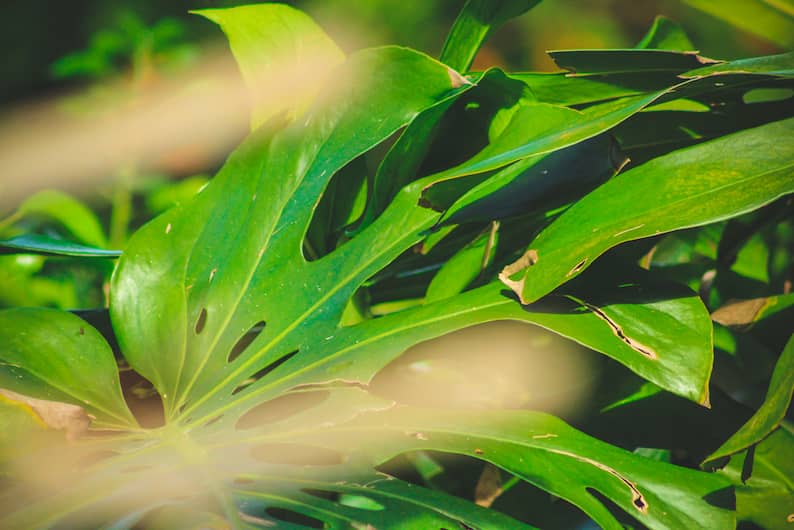
Table of Contents
Why are my Monstera leaves curling?
The main reason why your Monstera leaves are curling is usually due to underwatering. If the leaves are also dried out and slightly crispy, this is also evidence that your plant isn’t getting enough water. However, other potential reasons for Monstera leaves to curl include overwatering, excess fertilizer, low humidity, heat stress, disease, and insect infestation.
It’s important as a plant parent to know all these causes. That way, you can identify what is ailing your plant.
1. Overwatering
Among the top issues that affect Monstera leading to leaf curling is overwatering. Excess moisture is harmful to indoor plants such as the Monstera. It often leads to diseases like root rot that can cause the plant to die.
If you come across one of the overwatered Monstera plants with curling leaves, check the topsoil. Also, consider your watering schedule. The more you water the plant, it causes sogginess in the soil. While Monstera loves moist soil, it can lead to problems with too much moisture.
See here for exactly how often to water your Monstera to get this problem under control.
2. Underwatering
Monstera are tropical plants that love moist soil. If the plant begins to curl its leaves, consider your watering schedule. How often do you water the Monstera plants in your home? A lack of moisture in the soil causes the plant to begin curling its leaves.
Most plant parents’ water often to prevent underwatering which is important. However, just a few forgetful weeks or a longer vacation than you expected and suddenly you’re at risk of underwatering your Monstera. Consider your watering schedule to not lean too much on the other side of the spectrum.
3. Excess fertilizer application
A Monstera growing outside in a garden has more nutrient access than one in containers. This is why it’s important to feed your indoor Monstera with fertilizer. It adds the essential nutrients the plant requires to grow tall and healthy.
However, too much of something is clearly not always a good thing. On that basis, another cause of Monstera leaves curling down is excess fertilizer application. As much as this plant requires nutrients, feeding it huge amounts over a short period causes a negative effect.
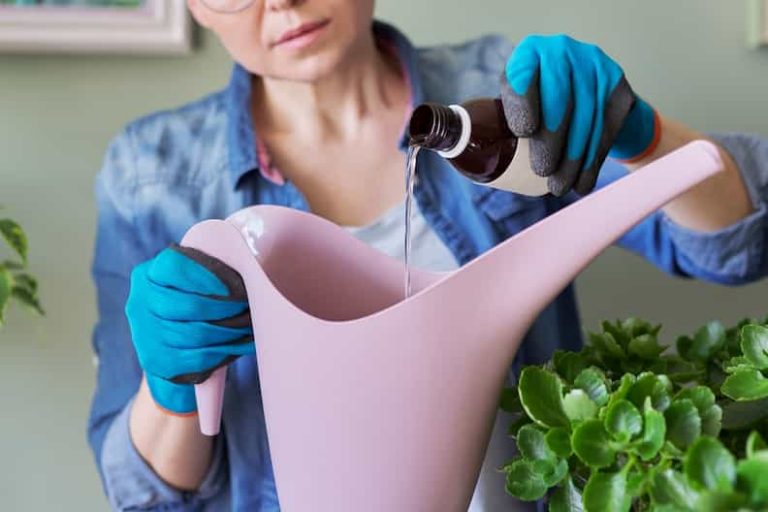
4. Low humidity
As you blast the AC unit in summer, this gets rid of most of the humidity in the house. As a result, you start to notice the once beautiful leaves of your Monstera curling down. It’s a clear sign that the environment around the plant is too dry.
In addition, when you turn on the heating system in winter, this results in dry air. Most of the moisture in the house evaporates, leaving very little humidity. Again, this will cause the broad and beautiful Monstera leaves to curl.
Find out more: 12 Proven Tips to Get Your Monstera the Humidity It Needs
5. Improper lighting
Less light causes the Monstera and many other houseplants to seek more. While others grow longer vines towards the light, Monstera leaves curl. The curling is outward towards the source of the light. The darker the area, the worse the curling issue with the plant.
On top of curling, improper lighting causes the Monstera leaves to start yellowing. The yellowing is easy to detect since the plant has deep dark green leaves. If you see the leaves curling outward and turning yellow, know the plant needs better lighting.
6. Heat stress
High temperatures in the house cause the Monstera plant to suffer from heat stress. If the temperature around your Monstera is too high, you’ll begin to notice the leaves of this plant looking droopy and curling. This is especially possible if the plant is near a heat source or vent, but could also be if it’s near a window where too much light can lead to your Monstera being sunburnt.
Also, the Monstera leaves will curl if the plant is in an area that receives direct sunshine. The harsh sun rays burn the leaves, causing brown spots on your Monstera. If you don’t move the plant, it begins to curl its leaves inward to prevent further sun damage.
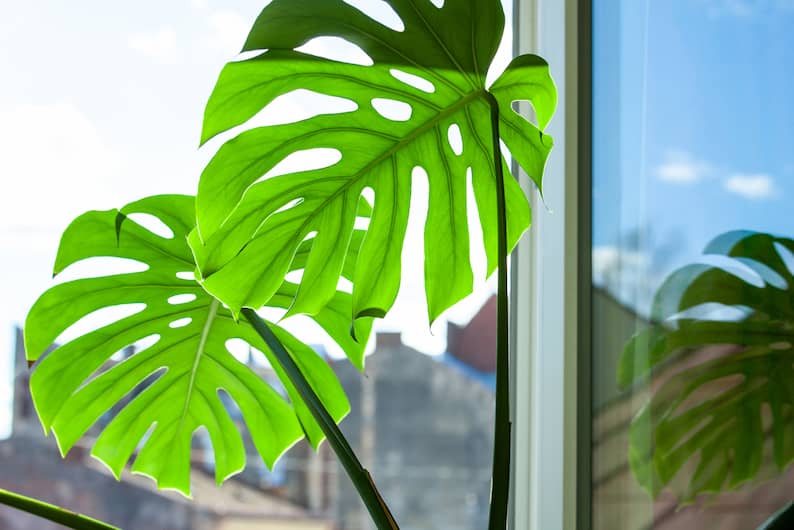
7. Disease
A sick Monstera begins to lose its luster and curl its leaves. The most common diseases that affect the Monstera plant include:
Bacterial leaf spot
The leaf of the Monstera plant starts to develop a yellow border and dark brown spots. Most of the spots that form on the leaves are of a similar size. You start to notice a sticky substance oozing from the brown spots with time.
The minute you spot this, isolate the plant to prevent transmission.
Anthracnose
This is a fungal disease that affects Monstera plants. Among the major symptoms, you’ll start to notice are your Monstera leaves curling and turning yellow. The infection happens along the edges causing your Monstera’s leaves to curl downward and turn brown.
If proper treatment isn’t done, the brownness spreads inwards and will kill the entire leaf and, eventually, the entire plant.
Root and stem rot
This relates to the overwatering point above, in that most house plants like the Monstera grown in containers are at risk of developing root and stem rot. One day you wake up and notice the entire stem of the plant is mushy – which could be accompanied by your Monstera leaves curling and turning brown or yellow. If you wait too long to investigate, you may find that the roots are long gone due to rot.
While it’s possible to reverse this effect, you have to do so before the mushiness sets in. After that, the plant is too far gone to save. You can see how to do so in our article on how to treat Monstera root rot.
8. Insect infestation
Watch out for insects that love to nest and eat Monstera leaves. When you get an infestation, the leaves will start to curl. These plants are quite susceptible to insect infestation, so always check when working on the houseplants.
Some of the insects that love to attack Monstera include:
- Thrips (take a look at our article on how to get rid of thrips on Monstera)
- Spider Mites
- Aphids
- Whiteflies
- Scale on your Monstera
9. Root bound and compacted soil
How often do you repot your Monstera plant? The plant gets root bound if you go years without repotting it or loosening the soil. The more the roots grow, the worse the situation. This can even cause the plant to stop growing for some time.
Another problem that a root bound Monstera causes is compacted soil. This causes less airflow in the root system of the Monstera plant. It’s therefore important to check if the plant is root bound when you notice poor growth and curling leaves on the plant.
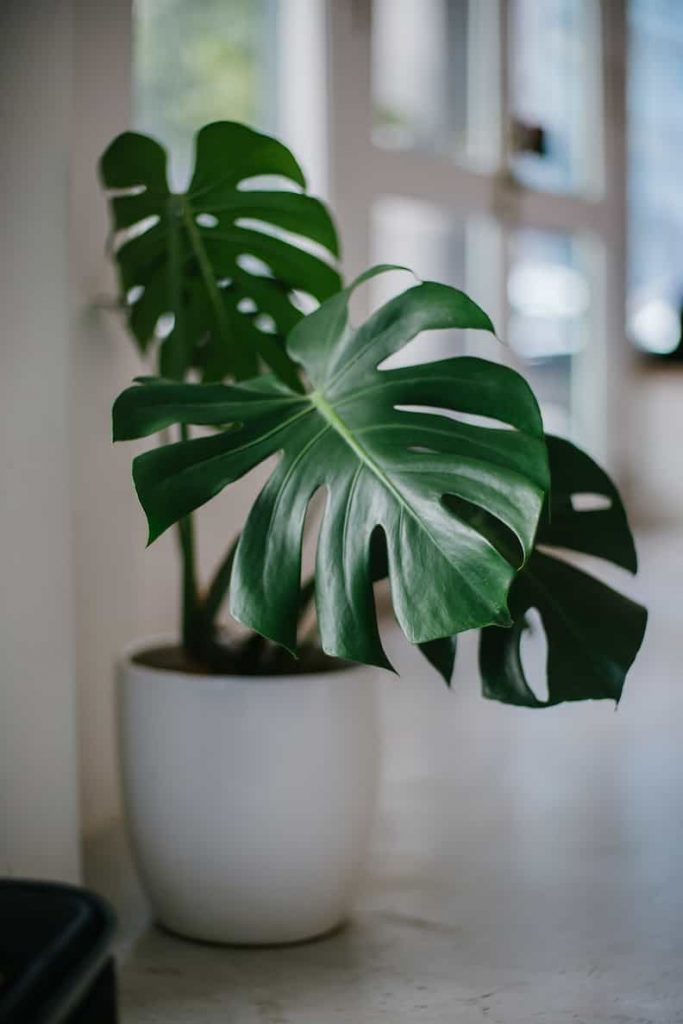
10. New growth
Curling leaves on the Monstera plant aren’t all a sign of problems. In particular, if you see new Monstera leaves curl, this may simply be a sign of new growth. Monstera leaves start out curled, and then they slowly uncurl when the leaves grow.
Investigating the curling leaves is crucial to see if it’s new growth or a sign of problems.
Related: 9 Easy Ways to Encourage Monstera to Grow New Leaves Faster
Can you fix curled Monstera leaves?
It’s possible to fix curled Monstera leaves, but it depends on the damage’s cause and extent. Monstera leaves curl because of numerous reasons. Manage the cause, and the leaves will uncurl. In most cases, this arises due to underwatering, so give your Monstera a good drink and it should recover.
Such problems are best handled fast. The minute you notice your Monstera leaves curling down, it’s time to act. Do an investigation to find out the cause and solve it. In most cases, you’ll notice a quick change in the plant as it gets better.
1. Control insect infestations
Aphids, thrips, and whiteflies tend to attack Monstera leaves. The minute you spot them, wipe the leaves using neem oil or rubbing alcohol. If the infestation continues, spray an insecticide.
2. Let the soil dry out
Overwatering will cause the leaves of the Monstera to curl. When you notice lots of moisture on the soil, you can fix the leaves by letting them dry out. Cease watering for some time and check the soil condition.
3. Water the plants properly
Correct watering will prevent underwatering and overwatering. When the plants are in the correct moisture content, the leaves should go back to normal.
The one exception is if overwatering has gone on for too long. In that case, you should consider repotting your Monstera in fresh soil, which will also give you the opportunity to check the roots for root rot.
If signs of this are present, it’s important to take action quickly to avoid it spreading and ultimately killing your plant.
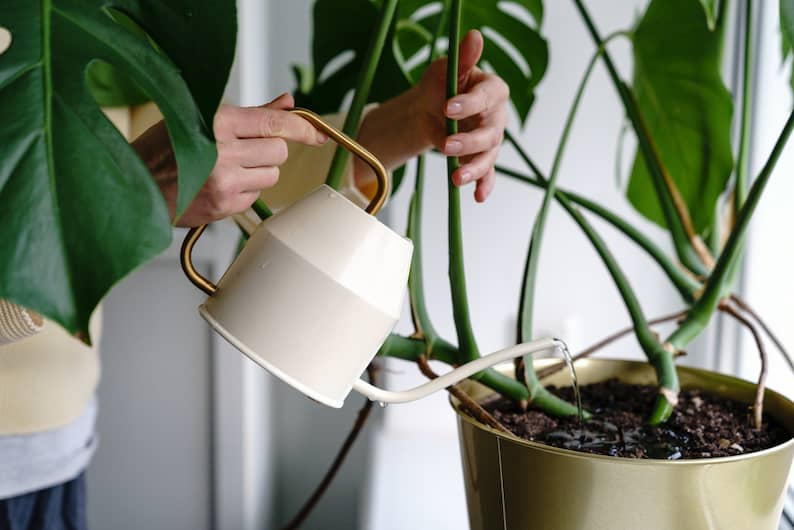
4. Control humidity
The Monstera loves moist soil and a humid environment like many other tropical plants. You might need to control the humidity levels in your home, especially in summer. If you want to be extra cautious about this, consider buying a hygrometer which will display both indoor temperatures and humidity levels.
One great part about this being the problem is that as soon as you get it right, you should notice your Monstera leaves unfurling relatively quickly.
5. Move the plant to meet its light needs
The Monstera has certain light needs that, if not met, can cause your Monstera leaves to curl. But whether it’s getting too much or too little light, the solution is the same: you need to move your plant (or get some grow lights).
Once it’s getting a more appropriate amount of light, you should notice your Monstera leaves unfurling towards the light source fairly quickly.
Do Monstera leaves uncurl?
Your Monstera leaves will uncurl if the issue that caused these leaves to curl is addressed in time. Those that do uncurl are normally those that aren’t too adversely affected by the problems ailing the plant. However, if the problem has gone on for too long, some leaves may not recover.
For instance, flashing the soil removes the excess amount if the leaves are curling because of nutrient buildup. The plant feels better and you should start to notice your Monstera leaves unfurling in no time.
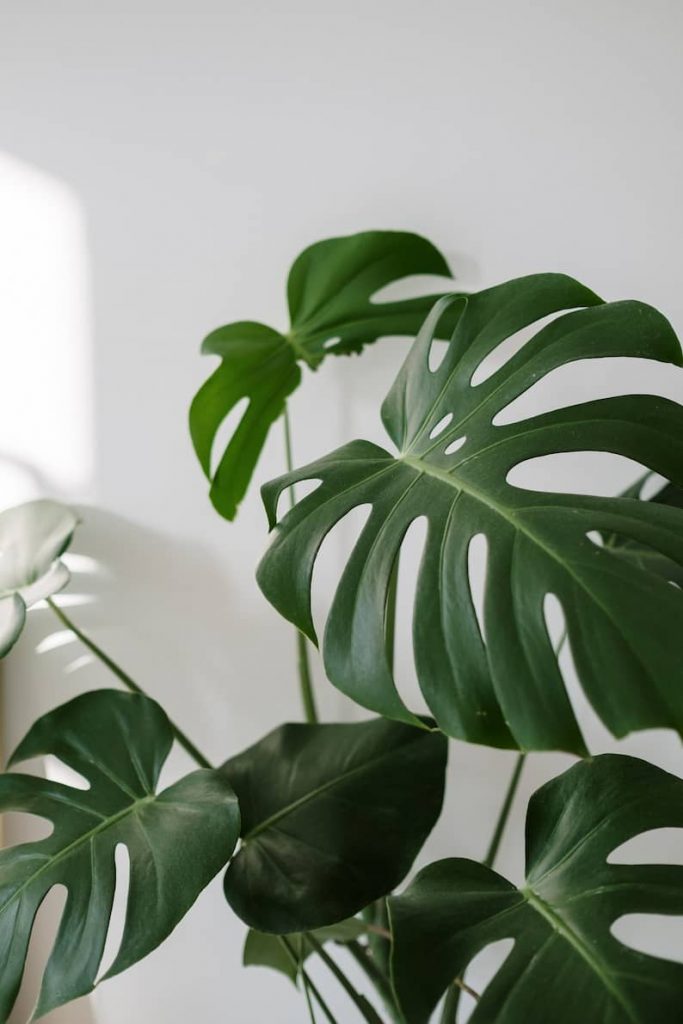
The same occurs when the curling is because of low humidity or due to the plant being root-bound. The leaves of the Monstera can uncurl if you act fast. Ensure the house has ample humidity suitable for the plant. Also, re-pot it in soil that’s not compacted for better growth.
However, if the leaves curl because of insect infestation or disease, the leaves may not uncurl. The best way to help your plants is to prevent infestation and disease. This keeps your leaves beautiful and uncurled.
How long does it take a Monstera leaf to uncurl?
Uncurling can take between 1 and 7 days, depending on the extent of the issue. The only way for this to happen is by providing the plant with the best environment. Ensure you water correctly, don’t overfertilize, and keep the plant’s environment humid.
In addition, keep the plant free of heat stress, re-pot it, and prevent insect infestation and disease. The longer the plant has been suffering, the longer it will take for your Monstera’s leaves to unfurl. If there’s too much damage, this might not happen at all.
How do you stop Monstera leaves from curling?
The best way to stop Monstera leaves from curling is by inspecting them to find out the cause. If you don’t know the problem, you won’t manage to help your plant babies. So, start by investigating the cause and then develop and implement a workable solution.
1. Have a watering schedule
Over or underwatering occurs when you don’t have a watering schedule. Instead, you water the plant when you remember or pass by the collection. Such random watering can lead to excess moisture in the soil or a lack of water. It causes the leaves of the Monstera to curl as a sign of trouble.
Therefore, to prevent this from happening, come up with a plan or even put an alarm. Get a moisture meter when you want to know if the soil has enough moisture. It’s also another great way to know when the houseplant needs water or not.
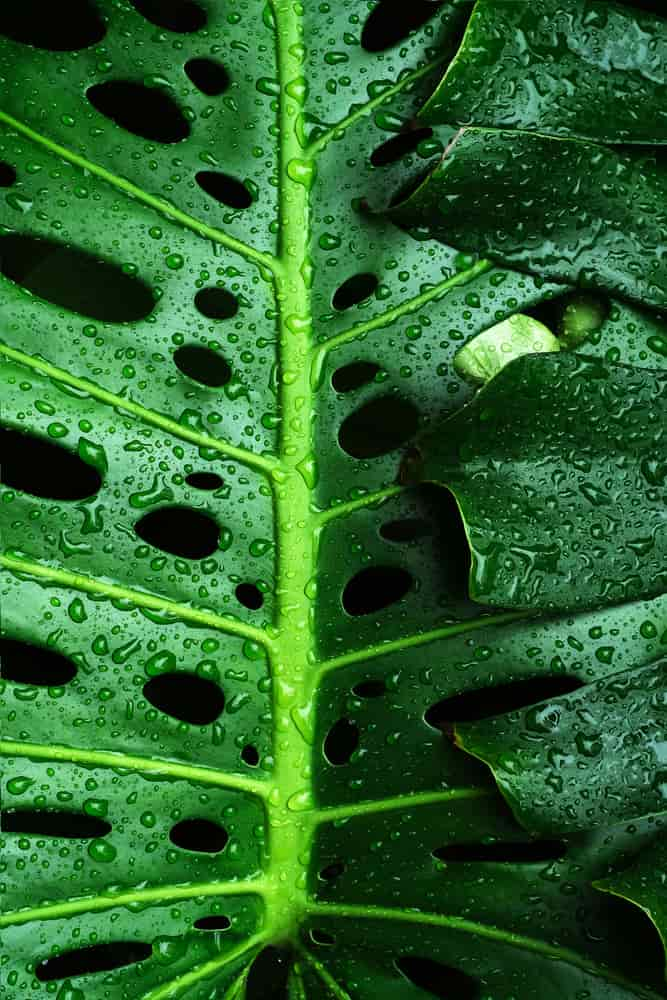
2. Avoid overfertilization
Most fertilizers come with instructions on how much to use on the plant. It’s best to add fertilizer to your Monstera during the growing months. Do so once every two months to prevent nitrogen and salt buildup in the soil.
If there’s already buildup in the soil causing leaves to curl, you have to drench it out. The best way is by watering the 3 to 4 times while checking that the excess moisture drains out. Repeating this action causes the water to dissolve the excess nutrients and drain them from the soil.
3. Keep the plant’s environment humid
Low humidity levels affect plants, especially the Monstera. It thrives in a humid environment, so dry air causes its leaves to curl. There are several ways that you can ensure the plant enjoys ample humidity, such as:
- Buying a humidifier. It’s possible to buy a small humidifier and use it where you keep the houseplants. This might mean having a special room or part of the house where you gather the plants, including the Monstera.
- Add a pebble tray under the plant. Pebble trays are a simple way to increase humidity levels around your plant as the water evaporates from the tray.
- Position your plants close to one another. If you have a houseplant collection, putting them near one another helps them all by increasing their collective humidity levels. It can also look great too!
- Place a bowl of water where the plant is in the house. The bowl of water will ensure the environment around the Monstera is humid and stop the leaf curling.
- While you can use the AC to keep the house cool in summer, avoid blasting it. Doing so keeps the air in the house and around the plants humid.
- Use a whole-home humidifier. In winter, it’s normal to want to keep the house as warm as possible. However, this leads to dry air, which lacks humidity. It’s better to install a whole-home humidifier to add humidity back into the house.
4. Proper lighting
Many houseplants, including the Monstera love areas in the house where there’s plenty of indirect light. Placing the plant in a dark area only leads to yellowing and curling leaves. Instead, find an area where indirect light comes in.
Get some grow lights if there’s a limit on the amount of indirect light coming into the house. The light from these lamps helps the plant enjoy the right intensity. Remember, plants need light during photosynthesis, so lack of it causes major problems.
Check out our top pick for the best grow light for Monstera.
5. Treat diseases
Diseases like bacterial leaf spots on your Monstera and fungus infections cause the leaves of Monstera to start curling. When you notice the plant isn’t well, the first thing to do is isolate it from the rest.
Next, treat the plant using herbicides. Also, cut off the infected leaves and allow the new growth to take shape. Ensure you follow the instructions on the herbicide to prevent further curling. Overexposure to herbicides can result in losing the whole plant.
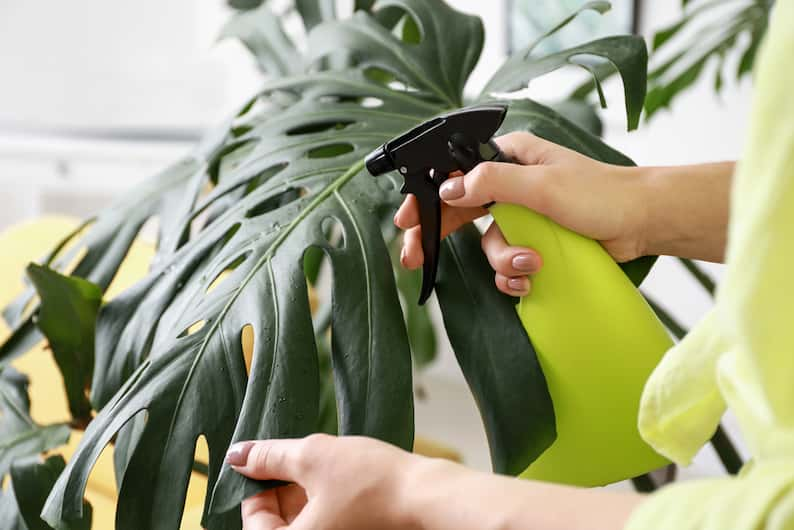
6. Prevent or tackle insect infestation
Insect infestations can cause irreversible damage to houseplants like the Monstera. The best way to protect them is through prevention. Using some neem oil or rubbing alcohol, make it a habit to wipe the plant’s leaves. The smell will send away any insects that want to invade the plant.
On the other hand, you can spray some insecticides if you already have an insect infestation. This will kill the insects then you can proceed to wipe the leaves. You can just use mild soap and water at times, which removes the insects from the leaves.
7. Re-pot the Monstera
Compacted soil and root-bound cause your plant to have curling leaves and stunted growth. The best way to stop the leaves from curling further is to re-pot the plant. First, start by removing it from the old pot and breaking apart the soil.

Doing so releases the roots and gives you a chance to trim them. Then fetch a bigger container and add the right Monstera mix (our picks for the best pot for your Monstera are here). Replant it in the new container and add more soil. Water the plant, and the leaves should start to uncurl.
Unfortunately, if your Monstera leaves are curling after repotting, the damage may be too far gone so you may have to consider disposing of the plant.
Final thoughts on Monstera leaves curling down
Monstera leaves will begin to curl when the plant is in distress. The situation is brought about by issues like over or under watering, excess fertilizer application, low humidity, and improper lighting. Also, watch out for heat stress, insect infestation, and disease.
Solving these issues will, at times, enable the curling leaves to unfurl. But note that if you see new Monstera leaves curl, this may be a sign of new growth. If you still notice your Monstera leaves curling after repotting, make cuttings and dispose of the whole plant and the soil in the pot.
